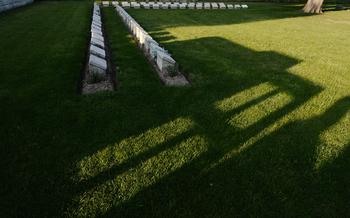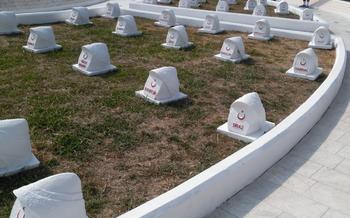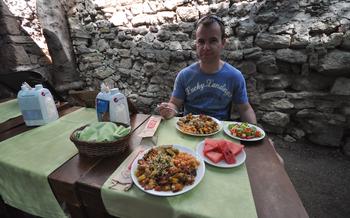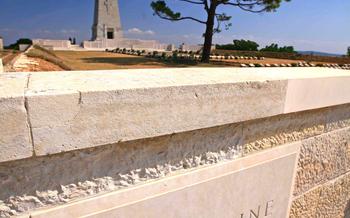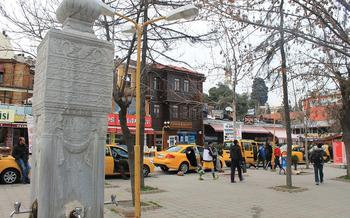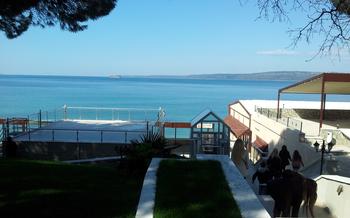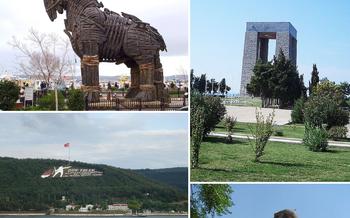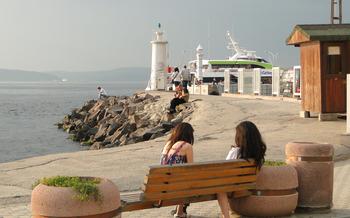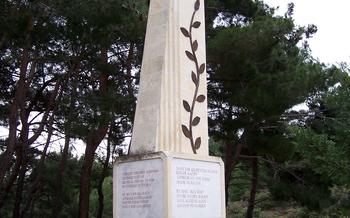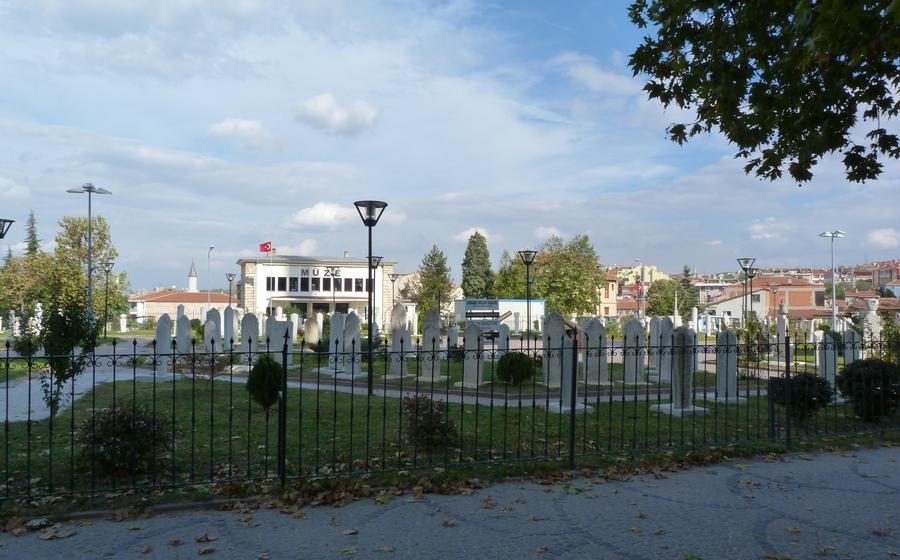
Gallipoli Peninsula Historical National Park
- Gallipoli Peninsula Historical National Park: A Place of Remembrance
- Explore the ANZAC Commemorative Site
- Discover the Lone Pine Cemetery
- Visit the Chunuk Bair New Zealand Memorial: Honoring the Sacrifices of New Zealand Soldiers
- Explore the Turkish Memorials and Cemeteries:
- Walk the Nek and Plugge's Plateau:
- Witness the Dawn Service at Anzac Cove
- Participate in Guided Tours:
- Visit the Gallipoli Museum: A Journey Through History
- Attend Commemorative Events:
- Respect the Significance of the Site
- Capture the Beauty of the Landscape
- Reflect on the Lessons of History
- Insider Tip: Plan Ahead and Be Prepared
Gallipoli Peninsula Historical National Park: A Place of Remembrance
The Gallipoli Peninsula, an evocative stretch of land located in northwestern Turkey, carries profound historical significance as the site of the infamous Gallipoli Campaign during World War I. This poignant landscape, forever etched with the memories of fallen soldiers, now stands as the Gallipoli Peninsula Historical National Park, a place of remembrance and reflection.
As the Allied forces, including troops from Australia, New Zealand, and Turkey, clashed on this peninsula, the ensuing battles left an indelible mark on the course of history. The campaign, which spanned eight months from 1915 to 1916, witnessed tremendous loss of life on both sides, solidifying Gallipoli's status as a symbol of sacrifice and resilience.
Today, the Gallipoli Peninsula Historical National Park serves as a sacred ground, a place where visitors from around the world come to pay homage to the fallen and gain a deeper understanding of the profound impact of this pivotal conflict. As they traverse this hallowed ground, they are reminded of the horrors of war and the importance of cherishing peace.
Explore the ANZAC Commemorative Site
The ANZAC Commemorative Site holds immense significance for the Australian and New Zealand forces who fought bravely during the Gallipoli Campaign. Established in 1915, this site serves as a poignant tribute to the ANZAC soldiers who made the ultimate sacrifice.
Key Features and Memorials:
-
ANZAC Cove: The landing site of the ANZAC forces, it features a sandy beach, cliffs, and memorials commemorating the fallen soldiers.
-
ANZAC Memorial: A striking obelisk that honors the memory of the Australian and New Zealand soldiers who fought in the campaign.
-
Lone Pine Cemetery: The resting place of many Australian and New Zealand soldiers, it's a serene and moving tribute to their sacrifice.
-
Johnston's Jolly: A former trench system that has been preserved as a memorial to the soldiers who fought and died in this sector.
-
The Nek: A site of intense fighting, it features trenches, tunnels, and memorials commemorating the fallen soldiers.
-
Plugge's Plateau: Another significant battlefield, it offers stunning views of the surrounding landscape and memorials to the soldiers who fought here.
Discover the Lone Pine Cemetery
Amidst the serene landscapes of the Gallipoli Peninsula, the Lone Pine Cemetery stands as a poignant reminder of the sacrifices made by Australian and New Zealand soldiers during the Gallipoli Campaign. Established in 1923, this hallowed ground is the final resting place for over 4,000 soldiers from both nations who lost their lives during the fierce battles fought in this region.
As you enter the cemetery, an aura of reverence envelops you. Rows upon rows of white headstones, each bearing the name of a fallen soldier, create a powerful visual testament to the immense loss suffered during the campaign. The meticulously maintained grounds and the respectful silence observed by visitors add to the solemnity of the site.
Among the graves, you'll find several memorials and monuments dedicated to the memory of the Australian and New Zealand soldiers who fought and died at Lone Pine. The Lone Pine Memorial, a simple yet poignant structure, commemorates the over 500 Australian soldiers who have no known grave. The New Zealand Memorial, located nearby, honors the more than 200 New Zealand soldiers who fell during the campaign.
Take a moment to pause and reflect upon the stories behind each headstone. Imagine the young men who left their homes and families to fight in a distant land, the horrors they witnessed, and the sacrifices they made. Their bravery and resilience in the face of adversity serve as a humbling reminder of the cost of war.
As you wander through the cemetery, you'll also encounter the Lone Pine Tree, a majestic Aleppo pine that has become an iconic symbol of the site. Surviving the ravages of war, this tree stood as a silent witness to the fierce battle that took place around it. Today, it stands as a symbol of hope and resilience, a reminder that even in the midst of destruction, life finds a way to endure.
Visit the Chunuk Bair New Zealand Memorial: Honoring the Sacrifices of New Zealand Soldiers
Standing atop the Chunuk Bair ridge, the Chunuk Bair New Zealand Memorial serves as a poignant tribute to the sacrifices made by New Zealand soldiers during the Gallipoli Campaign. This memorial holds immense significance for New Zealanders, commemorating the fierce battle that took place on these grounds in August 19
The memorial, designed by New Zealand architect Charles Reginald Ford, features a 17-meter-high obelisk crafted from white Oamaru stone, a material commonly found in New Zealand. The obelisk is adorned with bronze plaques bearing the names of nearly 850 New Zealand soldiers who lost their lives during the campaign.
At its base, the memorial is surrounded by a Field of Remembrance, where individual plaques commemorate those who have no known grave. Visitors can wander through this serene space, paying their respects to the fallen soldiers and contemplating the immense sacrifice they made.
The Chunuk Bair New Zealand Memorial stands as a symbol of the courage and resilience displayed by New Zealand troops during the Gallipoli Campaign. It serves as a reminder of the profound impact of war and the importance of honoring those who have paid the ultimate price for their country.
Explore the Turkish Memorials and Cemeteries:
The Gallipoli Peninsula Historical National Park also encompasses Turkish memorials and cemeteries that commemorate the fallen soldiers of the Ottoman Empire. These sites pay tribute to the sacrifices made by the Turkish military during the Gallipoli Campaign. Visiting these memorials provides an opportunity to honor their memory and gain a deeper understanding of their perspective in the conflict.
The Turkish memorials and cemeteries are scattered throughout the park, offering a poignant reminder of the heavy toll the war took on both sides. Visitors can explore the well-maintained grounds and pay their respects to the thousands of Turkish soldiers who lost their lives. The headstones bear the names and ranks of the fallen, along with inscriptions in Turkish and sometimes English, providing a glimpse into their identities and sacrifices.
One of the most prominent Turkish memorials is the Şehitler Abidesi (Martyrs' Monument), located on the hilltop overlooking the Dardanelles Strait. This impressive monument symbolizes the heroism and resilience of the Turkish soldiers. Its intricate design features a domed base surrounded by columns and topped with a crescent and star, representing the Turkish flag. Visitors can climb to the top of the monument for panoramic views of the peninsula and the surrounding landscape.
By visiting the Turkish memorials and cemeteries, travelers can gain a comprehensive understanding of the Gallipoli Campaign. These sites serve as a reminder of the immense loss and suffering experienced by all sides involved in the conflict, emphasizing the importance of peace and reconciliation.
Walk the Nek and Plugge's Plateau:
The Nek and Plugge's Plateau are two significant sites within the Gallipoli Peninsula Historical National Park that hold immense historical significance. These areas were the scene of intense fighting during the Gallipoli Campaign of World War I, where Turkish and Allied forces engaged in fierce battles.
The Nek: - Located on the Anzac sector of the peninsula, The Nek is a small ridge that witnessed some of the bloodiest fighting during the campaign. In August 1915, Allied forces launched a disastrous attack on the Turkish positions at The Nek, resulting in heavy casualties. The site now features a memorial dedicated to the fallen soldiers.
Plugge's Plateau: - Another crucial battlefield, Plugge's Plateau, is situated on the Turkish side of the peninsula. Named after a German officer who played a key role in its defense, the plateau was the site of intense trench warfare between Turkish and Allied forces. Today, visitors can explore the preserved trenches and fortifications, gaining insights into the harsh realities of life on the front lines.
Walking through these battlefields provides a profound connection to the past and allows visitors to appreciate the sacrifices made by soldiers from both sides. It is an opportunity to reflect on the futility of war and the importance of promoting peace and understanding.
Witness the Dawn Service at Anzac Cove
Each year, the Gallipoli Peninsula Historical National Park becomes the backdrop for a poignant and solemn tradition: the dawn service at Anzac Cove. Held on ANZAC Day, April 25th, this commemorative event draws thousands of visitors from around the world who gather at the break of dawn to pay their respects to the fallen soldiers of the Gallipoli Campaign.
The dawn service holds immense significance for Australians and New Zealanders, as it marks the anniversary of the first landings of their troops on the Gallipoli Peninsula in 19The service begins before sunrise, with the gentle glow of lanterns illuminating the tranquil waters of Anzac Cove. As the first rays of sunlight pierce the horizon, a hush falls over the crowd, and a lone bugler plays the haunting melody of "The Last Post."
The dawn service is a moving tribute to the courage and sacrifice of the soldiers who fought and died during the Gallipoli Campaign. It is a time for reflection, remembrance, and reconciliation. Attendees stand in silence, their heads bowed, as the names of the fallen are read aloud. Wreaths are laid at the memorials, and prayers are offered for peace and understanding.
Participating in the dawn service at Anzac Cove is a profound and deeply moving experience. It is an opportunity to honor the memory of those who gave their lives in the pursuit of freedom and to stand in solidarity with those who continue to work towards a world free from conflict.
Participate in Guided Tours:
Guided tours of the Gallipoli Peninsula Historical National Park offer a wealth of benefits for visitors seeking a deeper understanding of the site's history and significance. Led by experienced guides, these tours provide insights into the key events of the Gallipoli Campaign, the sacrifices made by soldiers from both sides, and the enduring legacy of the conflict.
By joining a guided tour, visitors can gain a deeper appreciation for the strategic importance of the peninsula, the challenges faced by the troops, and the impact of the campaign on the course of World War I. Guides often share personal stories and anecdotes from soldiers, bringing the history of the park to life and creating a more immersive experience for visitors.
Guided tours typically cover various key sites within the park, including the ANZAC Commemorative Site, Lone Pine Cemetery, Chunuk Bair New Zealand Memorial, and the Turkish memorials and cemeteries. Guides also take visitors to the Nek and Plugge's Plateau, where they can explore the trenches and fortifications that were the scene of intense fighting.
Participating in a guided tour is an excellent way to make the most of your visit to the Gallipoli Peninsula Historical National Park. With their expertise and knowledge, guides can provide a deeper understanding of the site's history and significance, ensuring a more meaningful and memorable experience for visitors.
Visit the Gallipoli Museum: A Journey Through History
Step into the Gallipoli Museum, a treasure trove of historical artifacts and poignant narratives that bring to life the story of the Gallipoli Campaign. Through immersive exhibits and interactive displays, the museum offers a comprehensive journey through the events that unfolded on this hallowed ground.
Discover the personal stories of soldiers from both sides of the conflict, gaining insights into their experiences, sacrifices, and the profound impact of the war on their lives. Witness the evolution of military strategies and technologies, from the early days of trench warfare to the introduction of new weaponry.
The museum's collection includes a vast array of artifacts, including uniforms, weapons, equipment, and personal belongings left behind by the soldiers. These tangible remnants of the past provide a powerful connection to the human toll of the campaign, evoking a deep sense of empathy and understanding.
By exploring the Gallipoli Museum, visitors gain a profound appreciation for the complexities and consequences of this pivotal historical event. It serves as a poignant reminder of the horrors of war and the importance of fostering peace and reconciliation.
Attend Commemorative Events:
The Gallipoli Peninsula Historical National Park hosts a range of commemorative events and services throughout the year, providing visitors with an opportunity to pay their respects and honor the fallen soldiers. These events hold great significance, fostering a sense of remembrance and unity among attendees.
One of the most prominent commemorations is the annual ANZAC Day service held on April 25th. This moving ceremony brings together descendants of the ANZAC forces, dignitaries, and visitors from around the world to pay tribute to the sacrifices made by Australian and New Zealand soldiers. The service includes a dawn service at Anzac Cove, followed by wreath-laying ceremonies and commemorative speeches.
Another significant event is the Turkish Commemoration Day, held on March 18th, which honors the Turkish soldiers who lost their lives during the Gallipoli campaign. This day is marked with ceremonies and prayers at Turkish memorials and cemeteries throughout the park.
Attending these commemorative events is a profound experience that allows visitors to connect with the history and significance of the Gallipoli campaign. By participating in these services, you not only pay your respects to the fallen but also contribute to preserving the memory of this pivotal event.
Respect the Significance of the Site
As a visitor to the Gallipoli Peninsula Historical National Park, it is crucial to maintain a respectful and somber demeanor. This sacred site serves as a memorial to the thousands of soldiers who lost their lives during the Gallipoli Campaign, and it is important to honor their sacrifice by behaving appropriately.
Please refrain from loud talking, laughing, or engaging in any disruptive behavior that may disturb the peaceful ambiance of the park. Instead, maintain a respectful silence and take the time to reflect on the significance of the site and the events that transpired here.
It is also important to be mindful of your actions when visiting the cemeteries and memorials within the park. These sacred spaces are dedicated to the memory of the fallen soldiers, and it is important to treat them with the utmost respect.
Avoid touching or disturbing any graves or memorials, and be sure to follow any specific guidelines or instructions posted at each site. By demonstrating respect and sensitivity, you can help preserve the sanctity of this important historical site and honor the memory of those who fought and died at Gallipoli.
Capture the Beauty of the Landscape
Beyond its historical significance, the Gallipoli Peninsula offers a breathtaking natural landscape that captivates visitors. The pristine beaches, rugged cliffs, and rolling hills provide a stunning backdrop to the poignant memorials and battlefields.
As you explore the park, take time to appreciate the beauty of the surroundings. Capture the golden hues of the sunset over the Aegean Sea or the vibrant colors of wildflowers blooming amidst the battlefields. The tranquil waters and sandy shores invite you to relax and reflect on the passage of time.
Photography enthusiasts will find ample opportunities to capture the essence of this unique place. Whether you're interested in landscape photography, historical documentation, or capturing the emotions of visitors, the Gallipoli Peninsula offers a wealth of subjects to inspire your creativity.
Remember to be respectful of the solemn nature of the site and avoid disturbing the peace and tranquility of the surroundings. Capture the beauty of the landscape with sensitivity, preserving the memory of those who fought and fell on this sacred ground.
Reflect on the Lessons of History
The Gallipoli Peninsula Historical National Park stands as an enduring reminder of the horrors of war and the futility of violence. The tragic events that unfolded here have left an indelible mark on the collective memory of nations, serving as a stark warning against the devastating consequences of conflict. Visiting the park provides an opportunity to reflect on the lessons of history, to understand the profound impact of war on individuals and communities, and to promote peace and reconciliation.
The sacrifices made by soldiers on both sides during the Gallipoli Campaign should never be forgotten. Their stories, etched in the memorials and cemeteries that dot the peninsula, are a testament to the courage, resilience, and humanity that can emerge even in the darkest of times. By learning from the mistakes of the past, we can strive to create a more peaceful and harmonious world, where conflicts are resolved through diplomacy and understanding rather than through armed conflict.
Insider Tip: Plan Ahead and Be Prepared
To make the most of your visit to the Gallipoli Peninsula Historical National Park, planning ahead is essential. Consider booking your transportation and accommodation in advance, especially if you're visiting during peak season. Remember to pack comfortable shoes for walking through the historical sites, as well as a water bottle to stay hydrated. It's also advisable to bring sunscreen, a hat, and layers of clothing to adapt to the changing weather conditions. By being prepared, you can ensure a smooth and enriching experience as you explore this significant historical site.

